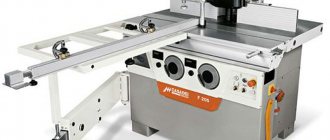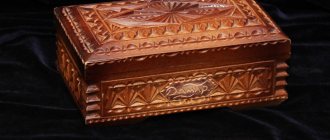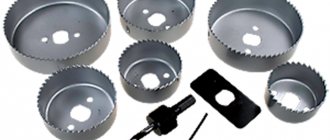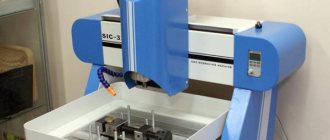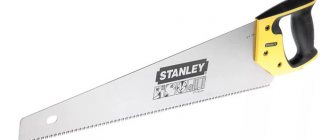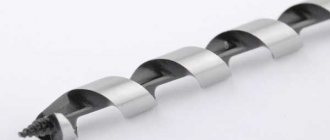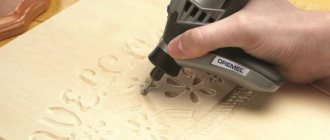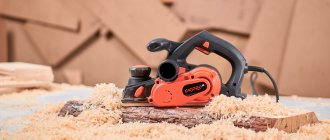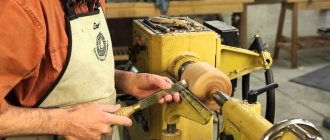Use a sander and the wood will look like a picture!
Conventional processing of various types of wood, as a rule, is not particularly difficult, so many people prefer to do it the old-fashioned way, using a plane, file and sandpaper. However, in this way it is difficult to ensure that the wooden surface becomes perfectly smooth and even. And here you can’t do without special mechanisms that will be useful to those who decide to make repairs, renew the wooden covering in a house or country house, as well as to those who professionally engage in wood processing.
Types of grinders
Despite the fact that these mechanisms are used for the same task, several types of structures can be distinguished, which differ greatly in their operating principle.
- a tape machine is an ideal choice for fast and high-quality processing of a large area (for example, floor surfaces, walls). The belt is fixed on guide rollers and moves at high speed (tracked vehicles work according to the same scheme);
The main components of the draw machine
Note! During operation, a lot of dust is generated, so manufacturers have improved the design of the device so that the dust is concentrated in a special bag or collected with a vacuum cleaner.
- eccentric sander - stands out from the rest in that the working surface moves both due to rotation and due to the operation of the eccentric mechanism. Its main advantage is that the output surface is perfectly smooth (when using a tape machine, small marks may remain on the wood);
Main components of an eccentric grinder
Note! It is the eccentric type that is suitable for processing not only flat, but also curved surfaces (both convex and concave).
- vibration mechanisms - in such mechanisms the working surface performs high-frequency vibrations with a small amplitude in the horizontal plane. For this purpose, the rotation of the eccentric is used. There are no restrictions on use; they have a fairly high productivity, so that they can be used both for floors and for finishing sanding of small products;
- Vibrating machines with a triangular-shaped working surface (ideal for processing corners in a room) are often classified as a separate type. The principle of operation is the same as that of a conventional wood sander, and the main differences are in the shape of the sole;
What is a sander?
For the convenience of processing internal and external surfaces of wood, plastic, metal or stone, a special grinding machine is used. This power tool is designed to make the product smooth, that is, to reduce the surface roughness coefficient. The device is actively used in the process of repairing car bodies, construction work, repairing walls and floors, and restoring furniture. The chopper significantly speeds up manual work and improves the quality of work.
Grinding machine device
A standard shredder, regardless of type, consists of the following elements:
- Commutator or brushless motor. The cost of the second grade is much higher, but does not require periodic replacement of brushes.
- Power supply. This may be a battery, a cord to connect to a standard power source, or a pneumatic installation.
- Working platform for attaching abrasive sanding sheets.
- Handle for ease of use.
- The control system, which includes a button to turn the device on and off, regulates the speed and monitors the performance of the device.
- A grinding disc, the diameter of which directly depends on the power of the device’s engine.
READ How to Correctly Cut Corners of Ceiling Plinth Video
Working principle of the grinding machine
The operation of a grinding machine for walls, metal pipes or wooden products is based on the principle of friction of the abrasive surface of the tool against the workpiece. As a result, the roughness of the product is reduced to the required parameters down to a perfectly smooth polished surface. All devices can have one of the following operating principles:
- Vibration with characteristic reciprocating movements.
- Circular motion around its axis.
- Combined or eccentric principle based on the symbiosis of vibration with rotation around an axis.
- Linear continuous movement of a special abrasive belt.
General recommendations for selection
The market is flooded with offers from little-known companies; in appearance, such models may not differ much from high-quality devices, but the difference will become noticeable only after some time. The price of such mechanisms may look attractive, but the savings will cost dearly in the future. So you need to know what to look for when choosing such mechanisms.
It is more convenient to give recommendations for choosing a specific model depending on its type, but you can also give some general advice.
In the store it is worth checking out:
- sander weight. It’s good if you don’t need to keep it suspended for a long time, in which case the weight of the machine can even be considered an advantage. But if you have to hold it in your hands, then preference should be given to a higher speed of movement of the working surface;
- its behavior when turned on. It is clear that a wood sander is not a quiet tool, but some models simply set a record, stunning their owners. Also, at idle, it is worth assessing the vibration; if the machine “hits” hard, then there is a high probability of its rapid failure;
- cost – it is quite possible to choose the optimal price/quality ratio without high expenses. The same Interskol produces a fairly reliable tool;
- the possibility of quick repairs also plays an important role, so exotics from this point of view are not the best choice; spare parts for not very common brands of mechanisms are difficult to find;
- The dimensions of the slab, mini-slab (about 100 mm 2) are suitable only for processing small wooden products.
Slab dimensions can vary greatly
Some craftsmen make something like grinders on their own. But a homemade machine is not able to compete with professional ones in terms of surface quality. The maximum that such a handicraft mechanism can be used for is processing small wooden parts.
How to prepare wood for sanding?
Wood is the material from which most furniture and interior elements are made. Its versatility makes it a raw material often processed by enthusiasts. To restore furniture, you need to properly prepare it. First of all, do not forget about safety. Buy a dust mask, as sanding produces dust that is harmful to the respiratory tract. Make sure the area you are going to work in is well ventilated. If you are going to use an electric sander, you will also need gloves and goggles.
Before you start sanding, clean the surface first. Make sure that the wood is not saturated with moisture. If you are not using a sander with a dust collection system, then prepare a vacuum cleaner or brush to remove dust. If using hand sanding, you will need a sandpaper block or holder. Prepare sheets of sandpaper of different grits and a wallpaper knife, with which you can cut the paper to the desired size. If you are using a grinder, prepare a set of discs.
If you want your wood to look its best after sanding and to last as long as possible in perfect condition, the first step is to get rid of any dust that may have occurred during sanding. You can use a soft cloth lightly dampened with water. This will help collect as much sticky and dry waste as possible. If you do not use a sander with a vacuum cleaner, it is worth repeating this action from time to time while sanding. The finished wood needs to be thoroughly impregnated so that it is not damaged in the future.
Which sander is best for sanding wood?
The choice depends on your skills. Experienced woodworking enthusiasts and professionals will likely use an eccentric or belt sander. An angle grinder is less recommended since it is most often used for cutting or fabricating metal. You can work with it on furniture, but then you need to be very careful because it can easily burn the sanded surface (especially when it does not have a speed control). The undoubted advantage of this power tool is its low price.
Read more about choosing and using a sander
Each of these types of sanders has its own characteristics, so when considering the question of which wood sander to choose, this must be taken into account.
Belt sanders
The power range of such devices ranges from 0.5-1.2 kW, and the belt speed is 100-150 m/min (depending on the manufacturer, simpler models have a lower speed limit of 150 m/min).
Note! Little-known manufacturers (especially from China) like to overestimate engine power. So, by succumbing to the magic of marketers, you can end up with a much less powerful device than you need.
When choosing hand-held wood sanders, the speed/power ratio is of particular importance. You can often find tools with high belt speed, but low power. This is done in order to minimize the risk of damage to the wooden surface, and it will be much easier to operate such a sander.
Speed control switch
Models with the ability to set a specific speed limit can be considered an ideal choice. If you need a universal option, then you can pay attention to slower models. If all the work is done with your own hands, then you can simply press the machine a little harder.
Additional nice touches include a dust collection bag (or a hole for connecting a vacuum cleaner), as well as devices for fixing the tool in place, turning it into a stationary one. The kit may also include special stops so that the machine can be moved along a straight or inclined line.
The photo shows a dust bag
There are a couple more little things that need to be taken into account when solving the problem of how to choose a belt sander for wood. The diameter of the front roller should be as small as possible, this will allow the surface to be processed with a minimum blind area. Also, some manufacturers make the roller barrel-shaped, which allows the belt to self-center.
Small diameter front roller expands tool capabilities
Choosing an eccentric and vibration machine
When choosing, pay attention to the following parameters:
- power, for modern mechanisms it is in the range of 200 - 900 W;
- the device must be equipped with an electrodynamic brake, which, after turning off the power, should instantly stop the oscillations of the plate. It is advisable to check this at idle speed;
- If you need a powerful tool, then the choice of a wood sander may be influenced by the presence of a starting current limiter. This allows you to avoid short-term network overloads and jerking of the plate during startup;
- the amplitude of the eccentric is in the range of 2-7 mm, and the rotation speed is 4-14 thousand;
- such devices can be equipped with elastic plates for processing curved surfaces;
Due to the elastic plate, curved surfaces can be processed
- Also, when choosing, it is better to focus on medium and small sized plates. Let the processing speed be a little slower, but there will also be fewer blind corners.
As for how to choose a vibration-type wood sander, you need to consider:
- Such devices have the minimum power among all listed; the power of most devices is in the range of 150 - 300 W. But there are exceptions - powerful professional grinders can be equipped with a 600-watt motor;
In the photo - a vibrating grinder
- a high-quality device should practically not vibrate at idle;
- vibration amplitude from 1-3 mm to 5-6 mm depending on the model;
- The type of sandpaper fixation is also important. Both the Velcro option and special spring-loaded clamps can be used.
It is impossible to give a definite answer to the question of which sanding machine is best for wood; it all depends on your goals.
Basic rules for working with the tool
At first glance, it may seem that using wood sanders is simple and anyone can cope with this task.
This is only partly true; in order for the machine to last a long time and the quality of processing to be beyond praise, it would not be amiss to consider the question of how to use a wood sander:
- before connecting to the network, you need to make sure that the power button is not in the “on” position;
- There is no need to press hard on the device. If a horizontal surface is being processed, then the device’s own weight is usually sufficient; in addition, with strong pressure, a high load is created on the motor, which reduces its service life;
There is no need to press hard, just hold the device with your hand.
- the device should be moved along the surface being treated at a constant speed; there is no need to rush;
- you need to understand that the tape does not last forever, so it is periodically cleaned of dust and replaced if necessary;
- if you need to process a small wooden part, then it is better to fix the sander itself and bring the wooden part to the plate;
- The operating instructions also require the use of personal protective equipment (gloves, goggles, respirator).
Personal protective equipment is essential
How to make something yourself with your own hands. Home master website
PURPOSE OF THE MACHINE FOR STEEL
An orbital sander (or surface sander) is designed for dry sanding of a flat surface. Using abrasive sheets of different grain sizes, it allows you to sand wood, metal, plaster and putty.
Plastic, stone, composite materials remove old paint, paints, rust, and “renew” wooden surfaces exposed to precipitation and high humidity. Used for fine finishing. Main areas of use: woodworking, furniture repair and manufacturing, repair and decoration, auto body work. There are also descriptions of ways to use the capabilities of this tool in non-standard ways, such as felting and preparing various solutions (to vibrate the body of the solution container).
EVERYTHING YOU NEED FOR THIS ARTICLE IS HERE >>>
OPERATING PRINCIPLE OF THE HAMMER
Vibration of the grinding plate of the device is achieved by rotating an eccentric connecting rod mounted on the motor shaft. Vibratory sanders have a rectangular base that makes reciprocating movements with a small amplitude, but at a very high speed.
The power consumption of a handheld vibratory sander is usually between 150 and 600 watts.
One of the most important characteristics of vibrating grinders is the amplitude of movement of the sole: the larger it is, the faster, but at the same time the surface treatment is rougher. These parameters should be taken into account when choosing a machine. Devices with an oscillation amplitude of 1.5-3.0 mm are used for fine grinding, and with an amplitude of 3.0-4.5 mm. for fast and rough processing.
Many models are equipped with devices for adjusting the idle speed in the range from 10 to 25 thousand rpm. This allows you to select an operating mode taking into account the characteristics of the surfaces being processed and expands the versatility of the tool.
It is good if vibratory grinders are equipped with a vibration regulator. This allows you to more accurately select the surface treatment mode. It's best to work at low speed to shred plastic.
The varnished surface is very sensitive to high temperatures, so for optimal results care must be taken to ensure that the temperature does not rise. Do not press too hard while operating the grinder . This will not speed up the work, but the wear on the mechanism will increase and the quality of the work will deteriorate.
Another useful feature. system of smooth rotation and locking of the switch. This improves surface finish and tool safety.
Most modern oscillatory sanders have dust removal systems through holes in the pad and sanding sheet. Dust generated during work is collected in a special bag or sucked from the workplace with an external vacuum cleaner.
Dust from grinding is very harmful to health. It enters the respiratory system, can accumulate in clothing, surrounding objects and settle in hard-to-reach places.
Using a dust collector ensures better sanding quality and increases the service life of the tool and sanding sheets.
Wood dust that is not properly cleaned can ignite under unfavorable operating conditions. overheating and tool malfunction.
Use personal protective equipment when working with a coffee grinder. Safety glasses, a respirator, and comfortable clothing and shoes reduce the risk of injury.
The sanding sheets are secured to the surface of the base plate using clamping arms or Velcro.
Some machines successfully combine both methods of attaching sanding sheets.
You must choose the right sanding sheets that match your sander model. Check the location of the holes on the sheet and select the correct grain size. Manufacturers of sanding machines also offer devices for punching holes in sandpaper (in the form of a template and a punch).
Consumables can also include a special sanding cloth and spray meshes. With their help, you can structure wood, clean metal from rust, and sand putties. By using a large mesh grinding mesh when treating putty surfaces, it is easier to remove dust from the vacuumed surface.
The presence of a sanding pad brake allows you to limit the operating speed in idle mode and increases the service life of the machine.
An interchangeable sand base of different sizes increases the versatility of the tool.
Also, the presence and design of additional handles affect ease of use. Powerful machines with comfortable handles are good for working in large areas, but working with small parts may not be practical in confined spaces.
READ How to Use a Circular Saw
Most power tools are equipped with an electric cable 1.5-4.0 m long. The longer the cable, the more maneuverable the tool. But a cable that is too long for small jobs can only get in the way.
When choosing a grinder, you should also consider its weight (usually it ranges from 1 to 3 kg). Lightweight machines are better suited for sanding “by weight”, for example, for walls and ceilings, heavy ones. for stationary work on large surfaces.
FEATURES OF THE STAILING MACHINE
Professional models are designed for continuous operation. The quality of the materials used in their manufacture, the reliability of components and electronics is higher than that of household vibrating grinders . Professional tools are designed for intensive work and therefore have higher performance requirements. When developing them, not only the requirements for maximum performance are taken into account, but also criteria such as ease of use, including minimal vibration of the machine body.
Household grinders operate on a “custom basis”. They typically have less power and weight, lower performance, and fewer additional features. After every 15-20 minutes of work, they need to “rest” at the same time, and it is recommended to work no more than 2-3 hours a day. The obvious advantage of household grinders is their lower cost.
I was happy with my choice. He managed to schedule the job in a few hours, regularly giving the machine a rest. This need was recalled by the increased temperature of the air cooling the engine and the slight heating of the housing. And my hands also periodically required rest or a change of profession.
The tool is comfortable in the hand and easy to use, has a powerful 300-watt motor, electronic control and a set speed (10,000.24,000 1/min), the vibration amplitude is 3 mm. The design of the machine ensures dust absorption through the perforated sanding pad, allows the use of Velcro sandpaper, as well. secure the sanding sheets with special brackets on the soleplate. To connect to the network, a 4-meter rubberized network cable with a quick-release connector is used. The weight of the tool is about 2 kg. It comes with a removable, reusable dust bag and a vacuum cleaner adapter.
The disadvantage is the lack of a device with punches to prepare normal skin for use with this product.
Nuances of choosing a chopper:
- The tool is equipped with a removable adapter for a vacuum cleaner.
- Reusable bag As the vacuum cleaner becomes full, its efficiency decreases. You need to monitor the filling of the bag and clean it regularly.
- The vibratory sander sole is covered with loops of polyamide thread, and there is a removable sanding sheet on the back. loops of threads with a side cutout, that is, hooks (loop tape and hook tape).
- Velcro fastening. comfortable, ensures clear and uniform placement
- Sanding sheets over the entire surface of the sole.
- Clamping machines are more versatile because it is easier to select consumables. You can use regular sandpaper (leather).
- The additional handle is convenient for working with the machine on large flat surfaces. If necessary, the handle can be easily removed.
- The rubberized network cable with a locking connector creates additional convenience for using the tool.
- The tool with accessories is packed in a plastic case. If you have a large number of power tools in your workshop, this is the most convenient way to store and transport them.
- Manufacturers have proposed a very simple and effective solution for connecting vacuum cleaners of different nozzle diameters to a vibratory sander. additional rubber sleeve (piece of rubber pipe).
All about wood sanders. Video
A wood sander is an ideal tool for finishing work in a country house. Using a sander significantly speeds up the process of processing wooden surfaces. With its help, you can update old floors, wood wall panels and any interior elements that have become damaged over time, including furniture.
The sander is the ideal tool for refinishing and sanding wood surfaces.
Features of work, purpose, types
There are different types of cable machines that perform the same type of work, but with completely different results. There is a grinding machine for coarse, medium and fine grinding.
In order to choose the right wood sander, you need to decide what type of work it is required for. One type is suitable for finishing grinding - bringing it to perfection; for rough grinding - leveling differences in height, unevenness - another type. Moreover, both problems can be solved using various types of equipment.
Draw machine
A wood belt sander is used for intermediate and rough surface leveling. By installing fine-grain sandpaper, you can achieve a medium-clean finish. This is quite enough for joinery that cannot be painted. To get it to perfect condition, a different type of sander is required. At the same time, to remove long longitudinal scratches, it is necessary to perform stepwise grinding, changing the grain size several times, since deep scratches remain.
What is the advantage of a belt sander? This device has excellent performance. The belt on this machine is installed so that one side can be sanded close to the wall surface. What are the main disadvantages? Due to the design features, it is not possible to “reach” all points.
For example, grooves, shaped recesses, corners and other small parts. It is not always possible to “climb” between two parts (for example, when processing a railing). The next drawback is that the main part of the draw machines has a rather large mass; it is quite difficult to work with these devices in weight, sanding vertical surfaces of walls. But on a horizontal surface they are the most productive.
Another drawback is that the grinding spot is not the largest and there is high noise. This device is so noisy that it is extremely uncomfortable to work without headphones. Why is the sanding spot small, since it looks quite significant? Even when the belt is large, this device grinds only in the center - the part at the back and front is not used, since it is raised on rollers for feeding.
The belt grinder has some operating features . In order to reduce the depth of the furrows, it must be driven along the fibers. In this case, finishing sanding will take less time. And one more thing - if you leave the machine in one place for a long time during operation, a large “hole” appears. Despite this, this is the most productive machine that is often chosen.
Eccentric (orbital)
The eccentric machine has a rounded sole with Velcro, where the sanding discs are fixed. The discs are exactly the same as those used for the angle grinder, so they are interchangeable. There are holes in the sole for removing dust, which is collected in a special bag. Almost all models can be connected to a construction vacuum cleaner.
The operation of this type of equipment is based on simultaneous forward-backward movement and rotation. This achieves a fairly high speed for finishing and intermediate processing of wood. When operating a grinder of this type, the platform moves in an orbit or spiral. Therefore, this instrument is also called orbital machines.
Orbital sanders are excellent when processing profile or curved surfaces - the device is easy to control, it is not very noisy, it is light in weight, the angle of the disk allows you to reach cuts, recesses, etc. At the same time, the equipment also processes large surfaces at a good pace. During installation, coarse sandpaper can be used for both intermediate and coarse sanding.
The disadvantages of this type of machine are that it is not possible to process corners. The round platform simply doesn't fit there.
Vibrating
The sole of this machine can be triangular or rectangular. During operation, it makes circular movements with a slight amplitude - it vibrates, which is what gave this type of device its name. This equipment is used for fine finishing - for painting or varnishing, but is characterized by low productivity.
A vibrating machine with a rectangular surface makes it possible to process large areas, but it cannot be used to sand wood near walls and vertical planes - the device begins to hit an obstacle. In this regard, the triangular one is more suitable for working in hard-to-reach places and corners, but it still cannot be placed tightly against the wall.
Also a disadvantage are the so-called “lambs”. If a grain of sand or other hard object gets under the surface, it leaves small circles on the tree - “lambs”. It is difficult to remove these traces. You have to use increasingly finer sandpaper, gradually removing scratches.
Wood sander: types
Today the market presents us with several types of grinding equipment intended for use both at home and at a professional level. Differences in design and the principle of its operation determine the purpose of the equipment; they are:
- belt sanders - designed for rough processing of surfaces made of wood, plastic and metal;
vibration types provide softer grinding, this is possible due to circular movements with a small amplitude. The surface of such a grinder is made in the form of a rectangle, which allows you to process hard-to-reach places;
Using a sander you can easily remove old paint
Another type is an eccentric sander, which allows you to process the surface so well that it becomes almost polished. This becomes possible due to the oscillatory-rotational movements that the plate makes. An eccentric machine is not suitable for processing small areas and internal corners.
The delta sander is convenient for grinding small recesses, corners, recesses
Design and use of draw machines
The grinding unit in this type of equipment is a belt that is attached around two rollers. The movement of the rollers allows the belt to rotate at the required speed. A fairly important characteristic of the operation of a wood sander is speed. The power of the tool depends on the rotation speed. This figure can range from 500 to 1200 W. There are models that are additionally equipped with a speed regulator, allowing you to select the optimal level depending on the surface being processed.
The grinding element of a belt sander is represented by a belt that is attached around two rollers
The dimensions of the belt vary depending on the model of the wood sander. The higher this indicator, the more functional the tool; at the same time, the weight of the structure and its dimensions significantly increase. When choosing a grinding tool, special attention should be paid to the grain size of the belt used. In order for the work to be of high quality and enjoyable, it is worth purchasing different types of tapes with different grain sizes.
Samples of grinding machines with a belt mechanism are equipped with a special device for collecting excess debris and dust that appears during operation. Some units are equipped with a pipe to which you can connect a vacuum cleaner.
To ensure that the work of a belt sander is high-quality and enjoyable, it is worth purchasing belts with varying degrees of grain size.
The quality of the tape depends on:
- the tape is elastic;
- the joints have no irregularities;
- the edge of the tape is straight on both sides;
- The strength of the tape is at a high level.
When performing significant volumes of work, belt sanders are equipped with a special design. This allows you to control the depth and quality of material processing, and for beginners they are simply a godsend, since they have no experience working with such machines. The market offers machines that have flat ends, this makes it possible to perform grinding work close to the wall of the room. Some examples of such machines have an additional function of automatic tape filtering.
The flat-face belt sander allows sanding work to be carried out in close proximity to the wall
Operating principle and application of a vibrating sander.
The vibrating machine works on the principle of oscillatory movements of the surface; sheets of abrasive material are fixed to it. They are fastened using special clamps or fasteners. This type of machine can grind surfaces made of metal, plastic, wood, and they can remove old paints and varnishes from coatings.
The operating principle of a vibrating machine consists of oscillatory movements of the surface on which sheets of abrasive material are attached.
The amplitude of vibrations is adjustable and depends on the purpose of the grinding surface, ranging from 4-5 mm to 1.5-3 mm. When choosing this type of grinder, you need to look at the speed of revolutions and oscillatory movements, as well as its power. If it is possible to adjust these indicators, then this is an additional advantage for the selected equipment.
Advantages of a delta sander
The base of such a machine resembles the shape of an iron. Excellent for processing almost any hard surface. It is used to bring life to old furniture and old window frames. The shape of the iron allows you to grind in hard-to-reach and narrow places.
The sole of the delta sander is made in the form of a reduced iron
The speed of the machine is quite high. When purchasing, pay attention to those models that are equipped with a speed control function and the ability to rotate the sole at different angles. Some are equipped with additional attachments that can be freely attached.
Sandpaper for grinding machines
Grit, also known as roughness, is a key parameter for any type of sandpaper. The grit size is always indicated on the back of the sanding paper after the letter P or the word Grit; sometimes both designations are used at once. Grit is determined by a number from 12 to 15,000, sometimes even more.
In its simplest form, this figure is the number of abrasive particles per square inch if they are spread in a continuous, uniform layer. In reality, this number is determined by the number of wires per square inch of the sieve through which the abrasive was sifted.
The actual size of the particles ranges from visible to the naked eye (1–1.5 mm) to completely microscopic (whole and tenths of a micron).
- Let's determine the scope of sandpaper depending on the grain size:
- up to P80 - for rough grinding and grinding to level the surface;
- from P100 to P220 - used at the second stage of grinding, if it is necessary to eliminate small grooves and scratches;
- up to P280 - used for fine grinding;
- smaller skins are already classified as polishing.
The rule for choosing sandpaper by grain size is very simple - the higher it is, the smoother the surface will be after processing. But at the same time, the finer the sandpaper, the faster it wears off, and the layer of material removed becomes smaller.
It should also be taken into account that the greater the hardness of the material being processed, the coarser the paper can be used for finishing. At the same time, on soft wood, even with a grain size of P220, quite visible scratches may remain.
Dry and wet grinding mode
Depending on the abrasive material and its binder, sandpaper may differ in the permissibility of sanding with wetting of the surface. Besides the fact that wet sanding paper is more expensive than regular paper, there are a number of other reasons why this distinction is important.
When removing particles from the surface being treated, the frictional forces at certain points can be so high that the generated temperature is sufficient to sinter the metal dust.
This is particularly true for aluminum and most non-ferrous metals: if the skin is not periodically shaken off, it will quickly clog and become unusable.
In some types of paper, this problem is solved by using a special abrasive material. Thus, silicon carbide, especially when deposited electrostatically, is capable of crumbling, forming new cutting edges, so such paper practically does not clog.
However, there can be really a lot of particles of the removed material, for example, when processing plastic, and then it is necessary to prevent their sticking together by moistening the sandpaper with water.
Resistance to wetting is determined by the standard, which is indicated at the end of the marking on the back side. Paper in accordance with GOST 13344–79 allows work in a humidified environment, but in accordance with GOST 6456–82 it does not.
There are exceptions, because water resistance is generally determined by the type of binder, that is, glue. Although the type of binder is usually not specified, abrasives bonded with synthetic substances are suitable for wet processing: bitumen, polyester resins, phenolic varnishes, etc.
Very often, the possibility of using paper for wet work is additionally indicated by the letter “B” or the word Waterproof.
For manual processing
Often a home craftsman has to process his products by hand. This way the quality of grinding is much higher, leaving fewer untreated areas. For manual processing, paper is available in sheet, strip and roll formats.
The most popular types of grain size in the household are fabric paper P60, P80 and P120. Smaller skins usually have a paper backing. It is recommended to always keep in stock different numbers of abrasive paper for fine grinding up to P400.
Fabric-based sandpaper with a grain size higher than P300 is produced primarily for machine processing, although it can be worked by hand with varying success.
The main difficulty is that the abrasive is filled with a solid layer of binder, and manual processing with such a tape is extremely slow, especially with high grain sizes. However, wet sanding with such paper is a pleasure.
Also, for manual processing, polyurethane sanding sponges will be very useful, which are very convenient for processing parts with small relief. If you are interested in woodworking, always have a supply of foam rubber sandpaper; this is the most effective preparation for painting or varnishing.
Belts and discs for machine sanding
It's hard to go wrong when purchasing consumables for grinding machines. All of them have a specific type and working dimensions - either length and width, or size number, or diameter.
For belt sanders and grinders, fabric-backed paper rolled into a ring is used. Length and width in millimeters are the main parameter of such sandpaper, determining suitability for use with a particular tool.
If you can still “play” with the width by using a narrower ribbon or tearing off the excess, then ribbons of arbitrary length can only be used on grinders with adjustable tension. Also note that the ring belt only has one direction of movement, indicated by the arrow on the back.
If you can still “play” with the width by using a narrower ribbon or tearing off the excess, then ribbons of arbitrary length can only be used on grinders with adjustable tension. Also note that the ring belt only has one direction of movement, indicated by the arrow on the back.
It's even easier with abrasive paper for rotary and delta sanders. They either fit in size or they don’t - the size of suitable consumables is clearly indicated in the instructions for the equipment. When choosing, you should also pay attention to the position of the holes for dust removal.
Since we are talking about power tools, almost all the sandpaper in the consumables is intended for dry sanding. All that remains is to select the correct grain size according to the type of material and the desired surface quality, and then gradually reduce it during the processing process.
Random orbital sanders
This type of wood sanding machine has the main advantage of a fine degree of processing. The round abrasive material that comes with the machine has different grain sizes, and the quality of the grinding work depends on it. Such models have dust removal through holes located in the sole.
The advantage of orbital sanders for wood is a finer degree of surface treatment
These types of grinders are characterized by high speed and number of oscillations. Adjusting speed and numerical indicators is an additional and very important function that allows you to select the ideal operating mode for various surfaces.
How to choose a shredder?
Before purchasing a sander for walls and ceilings, wood or metal surfaces, you need to determine the following factors:
- Scope and scope of application. All models have specific features of use, so the choice of a specific type of equipment and accessories depends on the purpose of the application.
- The intensity of work, which determines the power and required number of revolutions of the unit.
- Consumption and cost of abrasive materials.
- Type of power source used and specific application environment: pneumatic, standard electrical or battery.
- Availability of a dust collector or connection to a construction vacuum cleaner.
- Ergonomic use for a certain master.
- Vibration and noise levels.
- The price of the product, which is influenced by the class of the car and its manufacturer. For minor home repairs, you can choose a more budget model, while for professional use you should not save on tools.
- Warranty and availability of a service center in a convenient location.
Multifunctional renovator
This tool is considered an excellent backup to a wood sander. Its functionality has been significantly increased. In addition to standard polishing and grinding of surfaces, it can:
- create slots;
- clean tiles or glued linoleum;
cut communication lines.
The multifunctional renovator comes with many attachments, the use of which greatly helps in operation.
In its kit it has many attachments, the use of which greatly helps in the work. Among other grinding tools, it has a budget price and very low power consumption.
Any model of sander can be equipped with a battery. They are simply irreplaceable when carrying out long-term work in suburban areas where electricity has not yet been connected.
A multifunctional renovator with a special attachment will help you easily remove glued linoleum
Criterias of choice
When purchasing a specific model of grinding equipment, you should take into account the tasks that the power tool must perform in the future. The choice of professional or household equipment depends on this.
Professional wood sanders are ideal for long, active and continuous work. They will cost much more than household tools. For use without significant loads and long-term work, you should give preference to simpler grinders. If the choice is between a professional device and a regular one, then it is better to purchase the first option, despite its high cost. If the second one was chosen, then when working with it it is recommended to subject the device to less heavy loads. You need to pause every 3 hours. Only following simple operating rules will extend the life of the tool.
It is also important to consider the type of work for which the grinder is selected. For processing smooth surfaces, the optimal solution would be to purchase a belt sander. If there is a need for sanding or polishing decorative wooden products, it is recommended to purchase eccentric models. The ratio of the cost of consumables and upcoming costs during operation of the device also needs to be taken into account.
If you intend to use the grinding machine indoors, then you should pay attention to equipment with a built-in dust collector or the ability to connect a vacuum cleaner. Considering that the process of sanding surfaces will generate a lot of dust, you need to prepare for it to appear everywhere. Cleaning a room manually takes a lot of effort and time.
The length of the cord plays a significant role when choosing a sander model. Since it is inconvenient to work with a device on a short cord, and it is not always possible to use an extension cord.
We sell battery-powered tools that are useful for work in the country and in houses where electricity has not yet been installed. The cost of such models is high.
When choosing a device, you should test the location of the handles, check whether it is convenient to switch modes, and how difficult it is to hold the machine in your hands.
Safety precautions when working with sanders
Wood sanders require special attention to safety precautions. To protect yourself from unpleasant problems, you need to observe the following subtleties:
- wear headphones when working;
- use a respirator;
Do not neglect safety glasses.
An eccentric sander allows you to process the surface so well that it becomes almost polished.
Do not empty the dust container without unplugging the wood sander.
When using grinding tools on metal surfaces, it is necessary to ensure protection against sparks. There should be no flammable substances or other flammable mixtures in direct contact with, especially the operating device. Under no circumstances should children be allowed near it to avoid various injuries.
For large volumes of work, such equipment is equipped with a special stationary design. Such models control the quality and depth of processing and are ideal for beginners who have no experience working with such equipment. Manufacturers can offer a version of a wood sander that has flat ends. This sample allows you to carry out grinding work in close proximity to the wall. An interesting feature in which the feed can be automatically filtered will be a good help.
How to use a sander?
When used correctly, a hand sander is a safe and highly effective tool. Basic rules of its work:
- It is important to protect your eyes and nose from dust while working. Some instruments are very loud, so they can only be used with special headphones.
- Sparks are generated when working with metal surfaces, so the process is carried out away from flammable objects.
- The soleplate is replaced and adjusted only when the device is disconnected from the power source.
- After preparation, the abrasive device can be connected to the network.
- For belt models, the work center is concentrated before working in manual or automatic mode.
- Speed adjustment is required before starting work, but can be changed during operation.
- For uniform grinding, it is important to create and maintain equal pressure on the tool.
- After grinding, all contaminated parts of the machine are cleaned after cleaning the power source.
Source
How to Operate a Grinder
Sander _
woodworking is an indispensable tool when performing finishing work in a suburban house. The introduction of a sanding machine allows you to speed up the process of sanding and polishing wooden surfaces - wall cladding, floors, furniture, decorative parts. Wood sanders are comfortable and small-sized, allowing you to perform high-quality leveling of all wooden surfaces.
There are several main types of sanders for household use; their different designs and operating mechanisms determine their purpose. For construction and repair, carpentry and carpentry work, the following types of grinding machines are used:
Belt sanders are used where it is necessary to quickly remove a fairly thick layer of material, for example, for sanding an unplaned board or removing old paint from surfaces. LSMs are also used for precise fitting of parts and processing of the cut strip.
Test of the Metabo FSX 200 Intec 240 W eccentric sander, or sanding wood
The material is processed using an abrasive belt closed in a ring and stretched over rotating rollers. When moving, the belt removes a fairly thick layer of material, comparable to the service of an electric planer. The thickness of the removed layer depends on the grain of the abrasive belt.
